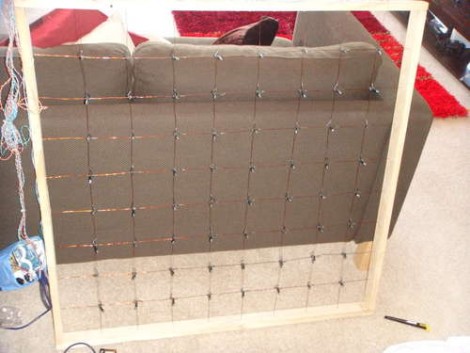
[Ndsit] is having a party and wanted to liven up the place with some blinky lights. He’s a bit new when it comes to hobby electronics, and although we’d highly recommend inviting some resistors to participate, the LED matrix that he built is very nice. It’s 8×8, it’s big, and (as shown in the clip after the break) the lights seem to hover in midair. That’s because he didn’t use a substrate to make the display. A grid of enameled wire is strung between the four sides of the wooden frame. LEDs were gathered from a string of Christmas lights which means they’re in a holder and have insulated wires already connected. Each one was tied on at a junction point of the grid, then connected to a portion of the wire where enamel had been scraped off.
It works but there’s already one light that is out. We hope some current protection is added so that this can be used again and again.
[youtubehttp://www.youtube.com/watch?v=3Cls45QWcSE&w=470]















You accidentally the link.
Looks like the LED equivalent of ‘Core Memory’ — in fact, that gives me a really good idea about building computer memory that you can “see” working.
@xeracy, you made me laugh out loud :D
the video doesn’t really show that it’s capable of smooth transitions. was kind of annoying that it flashes on and off every time it’s a new effect.
also, annoying lady in background is annoying.
@alan you forgot to mention the tv ads in the background are annoying.
As for the transitions, it’s run from an arduino uno so you can program it how you like.
@Techrat
Thats what I thought, he should try makinbg a 3D cube.
I also LOL’d
i got distracted because the girl in the background was eating ice cream cone and i was also eating ice cream cone
Far more elegant to ditch those green things and solder leds on directly. I would use fine gauge piano wire taught on the frame. Insulate with bits of wire strippings glued on place on crosspoints. One touch and that copper will stretch and look flabby. Current drive should be controllable in the processor. The dud could be the crappy green plastic “sockets”, leads bent over and shoved in in China.
@echodelta I would have taken a similiar approach (though probably found a thin-guage insulated wire to prevent damage to the controller in case somebody touched it). I’m guessing the LED’s he’s using (from a x-mas light set) are either A) Non-removable (like many x-mas lights) or B) Have 1cm leads on them. He was probably best off doing it the way he did given the LED’s he was using.